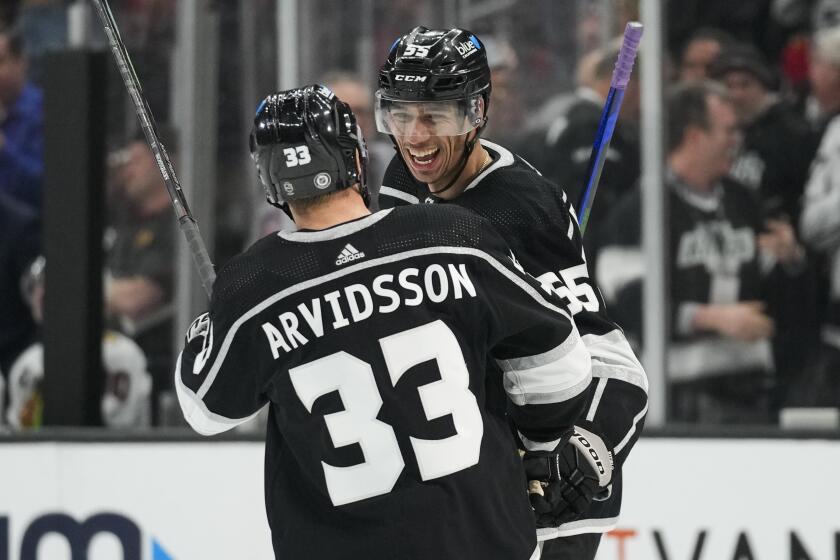The One-Back Game
As of the 2004 NFL season, fullbacks are passé. One-back football is here. And Clinton Portis will be the back on one of the NFL’s new one-back teams, the Washington Redskins, in their attack on the New York Giants Sunday in Giants Stadium.
Portis, playing without a fullback and undertaking his first run for the Redskins in Week 1, scored from 64 yards out on the third play of the game — heading left to begin with and, at the line of scrimmage, cutting away abruptly to his right.
On Coach Joe Gibbs’ first day back, that was almost all the offense Washington could muster. But in a 16-10 game, it was enough because the Tampa Bay Buccaneers, after Joey Galloway was injured, played without their top three receivers and their top running back, Michael Pittman.
It was in his first Washington tour (1981-92) that Gibbs first brought one-back football to the Redskins. And in the same era, Buffalo quarterback Jim Kelly rode the one-back to four consecutive Super Bowls. But as a power formation, it had been catching on slowly until this week, when, on opening night, Corey Dillon and Edgerrin James ran wild for the New England Patriots and Indianapolis Colts in a game New England won, 27-24.
The mystery is why any pro team uses a blocking back. Even if he makes a perfect block, there are two bodies in the runner’s way: the blocker and the man he’s blocking. Those bodies make it harder for a runner to slip and slide into the line, which is the essence of the modern running way. For, on an NFL ground play, there’s inevitably a small opening somewhere in the line if a fullback isn’t there shutting out the view, and, in Week 1, Portis, Dillon, James and Green Bay’s Ahman Green all swarmed through little gaps for big yards.
When instead of a fullback there is an extra tight end in the offense, there are always two directions in which to run. Alternatively, when an NFL team attacks with one tight end, one back, and three wide receivers, an offense can be even more disruptive. It’s taken too many coaches too long to figure this out.
Portis Can’t Take the Pounding
The Redskins misused their new tailback in the opener. After beginning the day with his 64-yard touchdown, Portis, 5 feet 11 and 205 pounds, ran 28 more times (a three-yard average) and was pounded on most plays.
At that rate, he’ll never last the season. The NFC East is a division whose teams want to beat the stuffing out of ballcarriers, and that is Portis’ fate now. It was also John Riggins’ fate when Gibbs had him in the 1980s, but Riggins, unlike Portis, was a big, tough guy.
Against the Buccaneers, Portis was usually running on first and second down — each of which is a running down in the Gibbs system — and usually failing to get a first down, meaning that Redskin quarterback Mark Brunell was usually passing on third and four or more. That is Gibbs’ passing down, but Brunell made no big hits. In fact, after their early touchdown, the Redskins scored only three field goals. Considering that Gibbs is basically an offensive coach, that wasn’t much offense in a game that could well have ended 6-3 (either way) if not for Portis’ dramatic, broken-play touchdown.
There are two principal Redskin problems. First, Gibbs had so much success as a running-play coach in the 1980s that he hasn’t yet moved into what has become a pass-play era. Second, though Redskin backup Patrick Ramsey is Washington’s best bet at quarterback, Gibbs thinks he’s too immature. During Gibbs’ first tour, a third-year pro passer normally was too immature. Not now.
A Packer Lesson in How to Run and Pass
The Green Bay Packers, operating most efficiently in one-back formations, easily won a 24-14 game Monday night from a Carolina team that looks like it hardly practices pass offense. The Panthers wore that look in the most recent Super Bowl. But that day, Carolina quarterback Jake Delhomme improbably, and uncharacteristically, hit a passel of long passes to nearly upset New England.
Against Green Bay’s blitzing defenses, Delhomme, a fine passer throwing to good receivers Steve Smith, Ricky Proehl and others, hit only a few key throws when the game was on the line. His performance was an indication that his coach, John Fox (a winner in numerous ways though he doesn’t know much about passing) needs to bring in a good pass offense coach as soon as possible.
The Packers lost the statistics but won the game convincingly with a modern two-front attack mounted by passer Brett Favre and runner Ahman Green, the same pair who for years have beaten back their competition by integrating their talents:
On Green Bay running plays, Favre was always threatening to throw. A statistical result was 119 yards gained rushing on 33 Green carries, an average of 3.6 yards per run.
On Green Bay pass plays, Green was a constant threat to run. One Favre result was 143 yards gained throwing on a 15-for-22 passing night, an average of 6.5 yards per attempt and 9.5 yards per completion.
The way Green and Favre integrated runs and passes — while their teammates addressed the problem of how to hold off Carolina’s blitzers — added up to a lesson in how to play winning football. To watch the Panthers, though, is to question whether they’re well enough acquainted with pass offense to understand the lesson.
Plummer Frustrates Pass Rush
The Denver Broncos under Coach Mike Shanahan are focusing more heavily than most teams on one strategic device — defeating the pass rush when their quarterback, Jake Plummer, drops back to throw. And in their next start, that device (the numerous pre-throw moves their quarterback makes) will be on view Sunday at Jacksonville.
The NFL cliché, a true one, is that a pass rush is the best pass defense; but when the Kansas City Chiefs rushed Plummer Sunday night, they didn’t get there often enough in a game the Broncos won from their archrivals, 34-24.
Shanahan protected Plummer from Kansas City’s blitzers by moving him all over the premises. Before unloading, the Bronco quarterback pulled away on rollouts, some long, some short, or on misdirection sprints — often threatening pass when Denver ran the ball the other way. Because Plummer threw out of the pocket only about 40% of the time and because, on most plays, the Chiefs never knew which way he was headed, their pass rushers could seldom draw a direct bead on him.
The Broncos also confused the Kansas City defense with their running game, which on most big plays was based on what they call “reach” blocking. On reach plays, Denver’s offensive linemen all rolled left or right at the same time, and when the Chiefs shifted with them — struggling to hold their defensive positions on the move — Bronco blockers reached some of them in time to open ample gaps for their new little running back, Quentin Griffin.
As Griffin and other Denver ballcarriers sprinted one way, Plummer sprinted the other way — sometimes with the ball, sometimes without — meaning that on a typical play he and Griffin were confronting the Kansas City defense from two directions at once. In his first start replacing Portis, the 5-7, 200-lb. Griffin gained 156 yards in 23 carries by comparison with Priest Holmes’ 151 in 26 for Kansas City.
Shanahan during his Denver career has always employed highly respected running backs — from Terrell Davis to Portis to, now, Griffin, a clever, quick sprinter who obviously has much strength for his size. It gets more certain every year that it is Shanahan, not Portis or the other running backs he’s had in Denver, piling up the ground-game yardage against the run blitz and the many other ploys conceived by NFL defensive coaches.
Broncos Win Bailey-for-Portis Trade
In the big trade of the year — offensive star Portis to Washington, defensive star Champ Bailey to Denver — the Broncos have stolen Bailey, their new shutdown cornerback. That in any case is the Week 1 judgment.
Portis in his Denver career ran the ball well for Shanahan, but who doesn’t? On the Redskin team, he isn’t rugged enough to be the every-down back Gibbs covets. On the Bronco team, Bailey fills a need that almost every NFL team has: the rare ability to single-handedly shut down any NFL wide receiver.
More than that, Bailey, on important occasions, was assigned to a tight end Sunday night and shut down Tony Gonzales, a Pro Bowl regular who is often called the best tight end in the league. Even more than that, Bailey played some offense and would like to play more.
The Broncos seemed stronger than advertised in most phases of football, notably on pass offense and defense. Their best receiver, Rod Smith, is still at the peak of his game, and Ashley Lelie finally seems to be getting the hang.
The Chiefs, however, competed strongly in total yards (with 318 to Denver’s 413) and in touchdowns (with three to Denver’s four) though not in big plays. The Broncos’ little scooter, Griffin, a 2003 fourth-round draft pick out of Oklahoma, slithered away on touchdown runs of 25 and 47 yards. And in the second quarter, when Plummer was having trouble scoring, pass receiver Griffin rescued him in the end zone to score Denver’s first touchdown. Such is the Broncos’ running game that if Griffin follows Portis out of the door to another employer, Shanahan can be relied on to find someone else.
Manning’s Dancing Audibles Upset His Own Team
The Indianapolis Colts will oppose their most dangerous AFC South adversary, the Tennessee Titans, in Sunday’s Game of the Week at Nashville in a September headliner that could well depend on whether Peyton Manning of the Colts, facing another great quarterback, Steve McNair, gives up on or lucks out on his audible-call foolishness.
He definitely didn’t luck out against New England. On Indianapolis’ final play of the game, Manning, though he had seemed to be getting the upper hand with his arm, cost his team the game with one of his dancing audibles.
Intending to confuse the defense, he confused, instead, his teammates, one of whom missed an easy assignment to block Patriot blitzer Willie McGinest. McGinest’s sack knocked Manning and the Colts out of easy field-goal position and out of the game, preserving New England’s three-point victory.
As always that time, Manning, when calling or faking an audibilized change of plays, strode up and down the line of scrimmage — and through his backfield — whispering the new numbers to the other folks on his team. In a road-game crisis, with the crowd on its feet and yelling along with the home side, that is as dumb a thing to do as it is foolish. For it forces teammates to focus not on their assignments but on what Manning is trying to say.
Football is difficult enough to play when you break from the huddle concentrating only on what you have to do next. It gets more difficult with any kind of audible. And when your quarterback is dancing around calling or feigning audibles, it gets to the point where at least one missed assignment is all but guaranteed.
This time, the guarantee opened up a clear lane for McGinest that was much wider than he is, and McGinest goes 270. At 33, the former USC star has slowed down. He still has the smarts and the old determination to win, to be sure, but he never would have gotten to Manning if any Colt had so much as stood briefly in his way.
Instead, lumbering in full bore, with nothing in his way but the night air, McGinest finally reached Manning from Manning’s right while Manning was looking left for an open target. Boom. There went Manning and there, perhaps, went Indianapolis’ season.
More to Read
Get our high school sports newsletter
Prep Rally is devoted to the SoCal high school sports experience, bringing you scores, stories and a behind-the-scenes look at what makes prep sports so popular.
You may occasionally receive promotional content from the Los Angeles Times.






